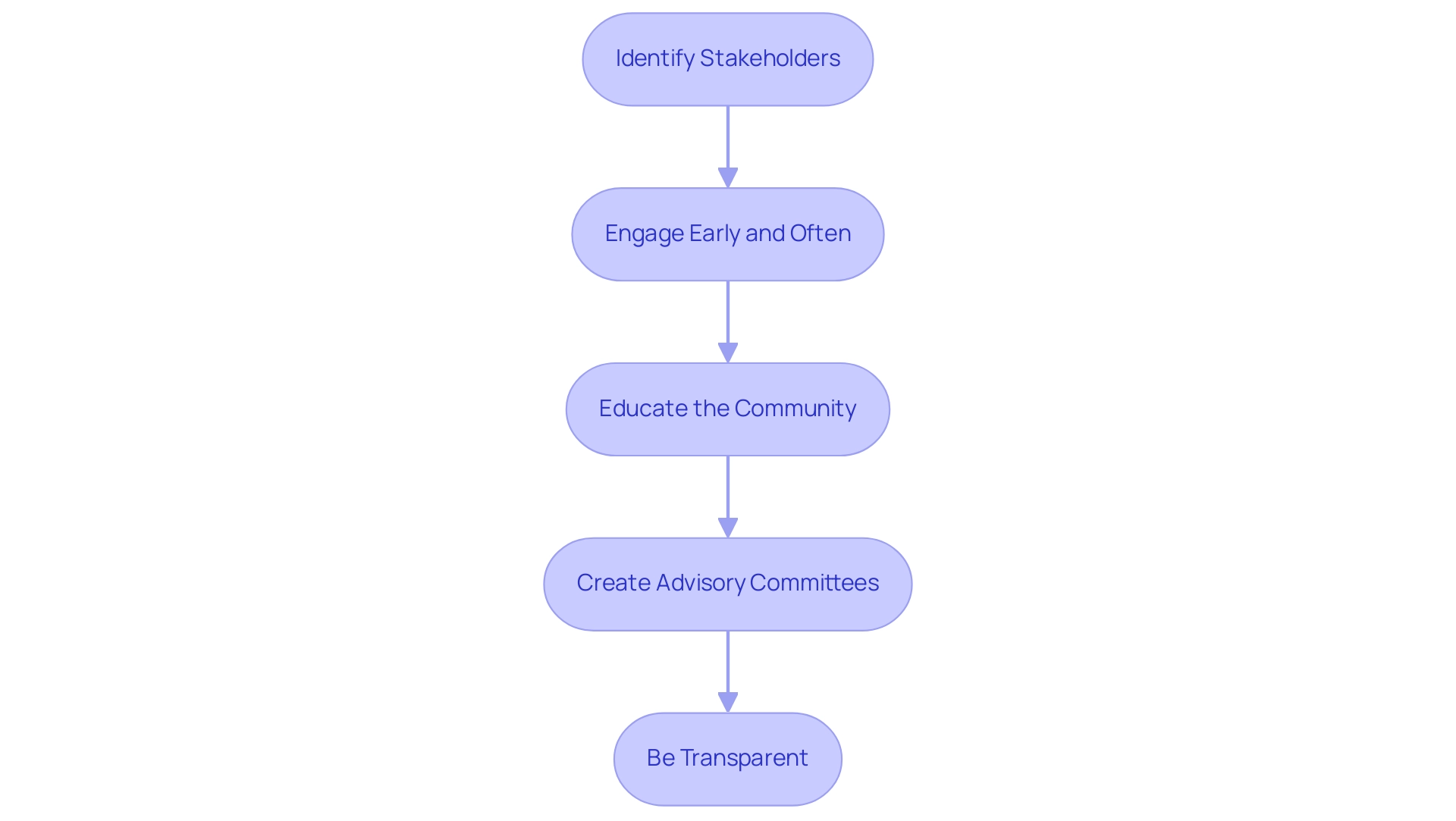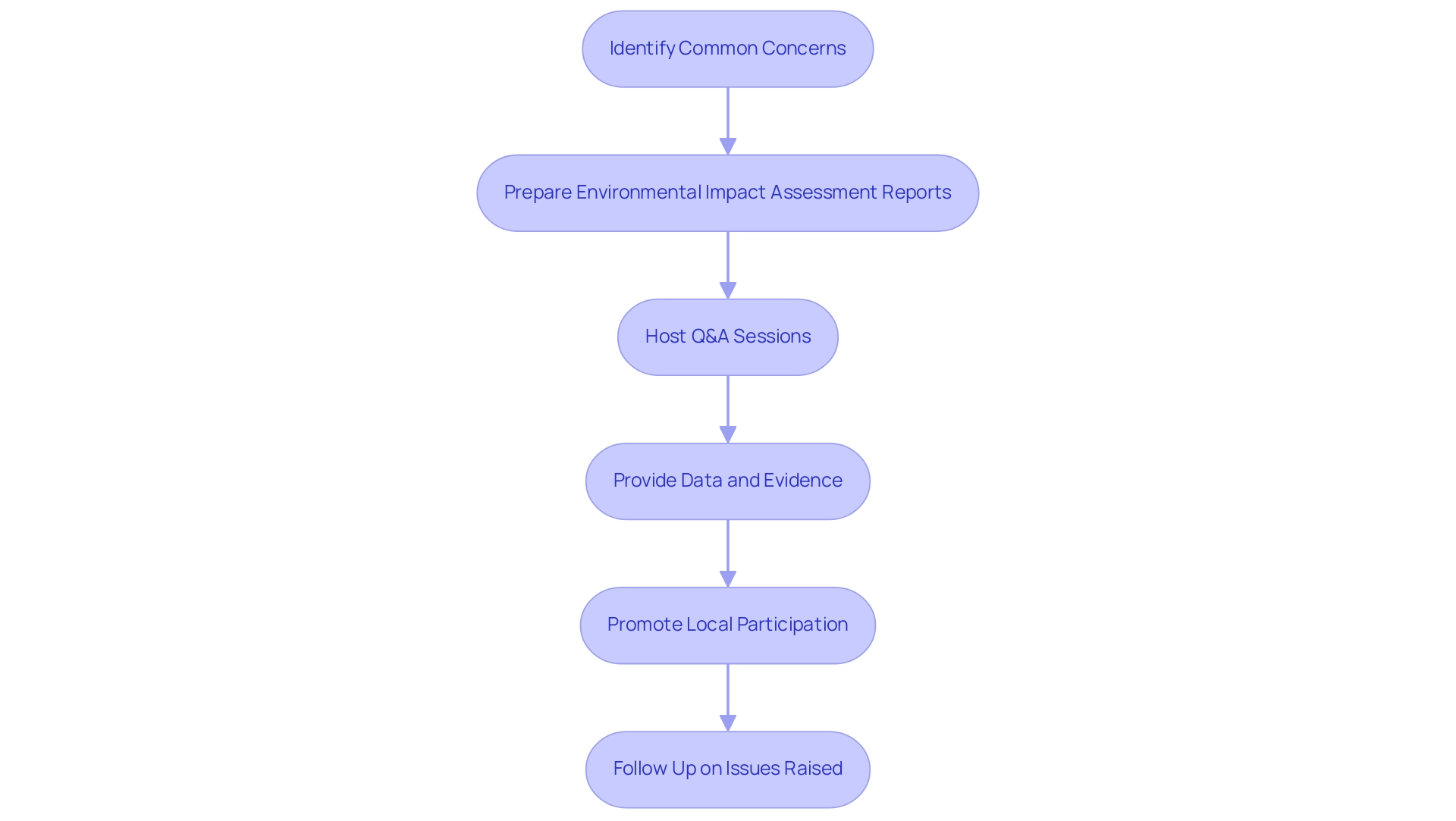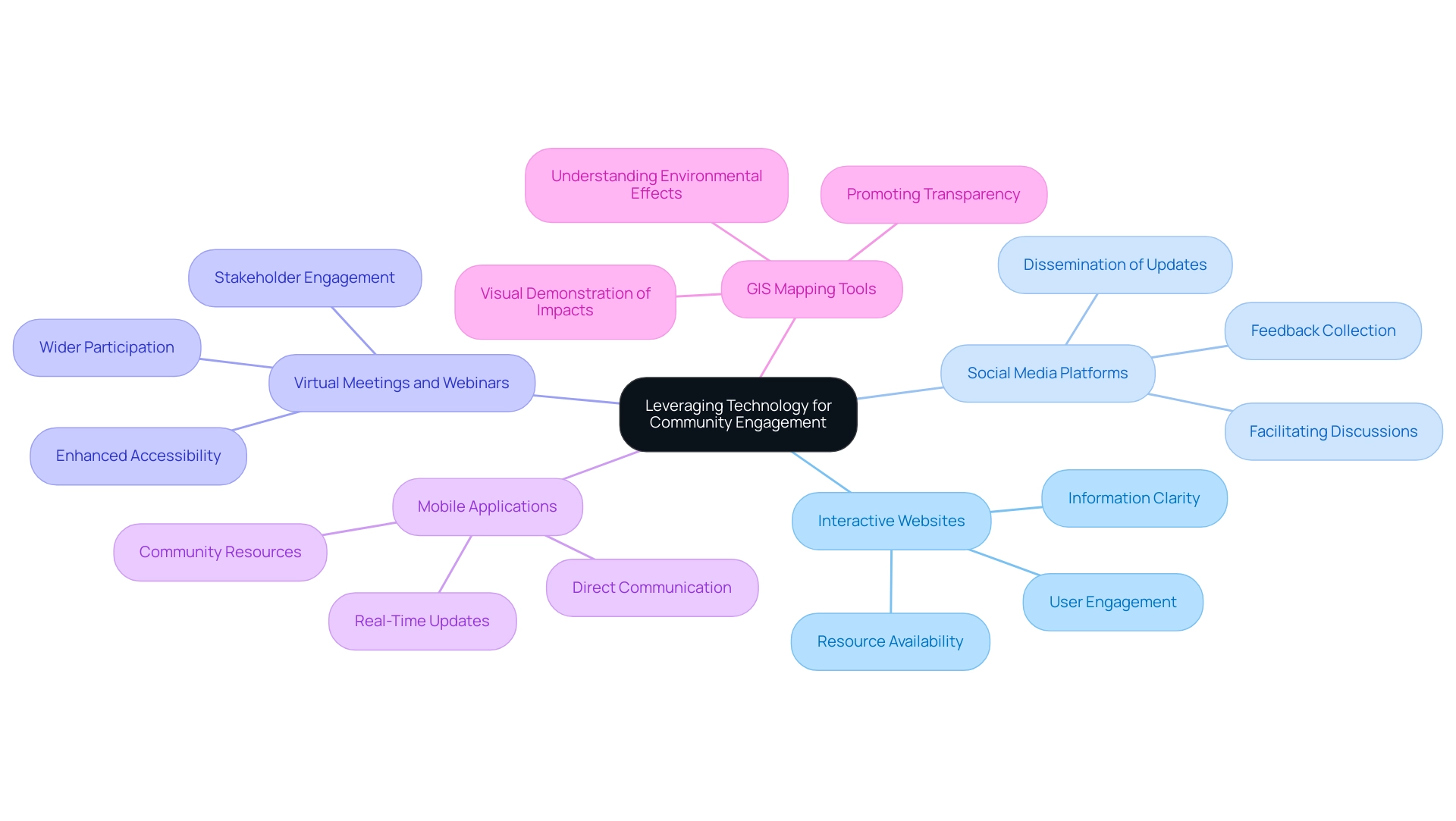Overview
Community partnerships for wind energy projects are essential for fostering local support and ensuring successful project outcomes. The article outlines key strategies such as early stakeholder engagement, education on the benefits of wind energy, and transparent communication, which collectively build trust and enhance community involvement, ultimately facilitating smoother project development and acceptance.
Introduction
In the pursuit of sustainable energy solutions, wind energy projects stand out as a promising avenue for both environmental and economic advancement. However, the success of these initiatives hinges significantly on the establishment of strong community partnerships. Engaging local stakeholders—from residents to government officials—requires a multifaceted approach that not only addresses concerns but also fosters a sense of ownership and support.
This article delves into the essential strategies for building effective community relationships, exploring the benefits and challenges of engagement, and highlighting innovative communication techniques that can bridge gaps between developers and communities. By understanding the dynamics of community involvement, project developers can enhance the viability of wind energy projects and ensure their long-term acceptance and success.
Building Strong Community Partnerships for Wind Energy Projects
To establish effective collaborations for wind energy initiatives, it is essential to follow these key steps:
- Identify Stakeholders: Start by thoroughly mapping potential stakeholders, which include local residents, government officials, and local organizations. Gaining a deep understanding of the demographics, interests, and concerns of each group is crucial for effective engagement.
- Engage Early and Often: Initiate communication with the group at the earliest stages of planning. As Commissioner Lori Cobos noted, interacting with the public is vital for ensuring project success. Consistent and frequent engagement fosters trust and allows stakeholders to express their concerns and suggestions, ultimately leading to more inclusive decision-making.
- Educate the Community: It is vital to provide clear and accessible information about the myriad benefits of wind energy, such as job creation, economic development, and environmental advantages. Organizing informational sessions and distributing comprehensive educational materials can significantly enhance public understanding and support.
- Create Advisory Committees: Forming advisory committees that include local members not only promotes inclusivity but also allows these representatives to actively participate in decision-making processes. This involvement can result in more customized outcomes that align with local needs.
- Be Transparent: Maintaining openness throughout the initiative lifecycle is imperative. Consistently share updates on progress, challenges faced, and how feedback from stakeholders has been incorporated into the planning and execution phases. This transparency establishes credibility and fortifies trust within the group.
By applying these strategies, developers can foster robust, cooperative relationships that improve acceptance of community partnerships for wind energy and ultimately lead to the success of the initiative. Recent findings indicate that 18% of developers recognized the value of public recommendations in their successful endeavors, highlighting the importance of stakeholder engagement in achieving positive outcomes. Furthermore, the financial consequences of local partnerships are considerable, with recent benefits agreements for renewable energy initiatives varying from $2,300/MW to $5,900/MW annually, highlighting the necessity for strong engagement strategies.

Understanding the Benefits and Challenges of Community Engagement in Wind Energy
Community involvement in renewable initiatives entails navigating a landscape of considerable advantages and obstacles that can affect success.
Benefits:
- Enhanced Local Support: By actively engaging in community partnerships for wind energy, developers foster a sense of ownership among residents, which leads to greater backing for wind power initiatives.
- Enhanced Initiative Viability: Community partnerships for wind energy are instrumental in streamlining the permitting process, reducing opposition, and facilitating smoother initiative development.
- Economic Development: Wind energy initiatives are known to generate jobs and stimulate local economies. Recent benefits agreements for wind projects indicate financial contributions ranging between $2,300 and $5,900 per megawatt (MW) annually, while solar projects show contributions ranging from $2,800 to $7,600 per MW per year. This comparison highlights the economic incentives accessible to groups.
- Projects that secure robust public support through community partnerships for wind energy often attain a social license, which is essential for their long-term sustainability and acceptance within the population.
Challenges:
- Varied Perspectives: The group may hold a range of opinions concerning renewable resources, which can result in disputes that necessitate thoughtful oversight and resolution approaches.
- Misunderstanding of Benefits: Many residents may not fully grasp the advantages of wind energy initiatives, underscoring the need for effective communication strategies to bridge this knowledge gap.
- Regulatory Hurdles: The regulatory environment can be complex, with local concerns potentially resulting in increased scrutiny during the approval process, complicating timelines.
- Establishing and nurturing community partnerships for wind energy necessitates long-term commitment, sustained effort, resources, and dedication from developers.
As Commissioner Lori Cobos noted, 'We’ve spent countless hours evaluating the PCM — up until, literally, my last open meeting,' emphasizing the significance of ongoing dialogue with the public.
A case study titled Public Involvement in Successful Initiatives indicates that 18% of survey respondents felt that public recommendations positively influenced their recent successful endeavor. This challenges the prevailing belief that public input may hinder initiative success, illustrating the potential advantages of public involvement.
By understanding these dynamics, developers can strategically approach public engagement, maximizing the benefits while effectively mitigating the associated challenges. This method not only encourages collaboration but also boosts the potential for successful outcomes.
Strategies for Effective Communication with the Community
To effectively engage with the community throughout wind energy projects, it is essential to adopt a comprehensive set of communication strategies:
- Utilize Multiple Channels: Employ a diverse array of communication methods—such as public meetings, social media platforms, newsletters, and email updates—to ensure outreach to various segments of the population. This multifaceted approach increases the likelihood of reaching individuals with different preferences for information consumption.
- Listen Actively: Create chances for local members to express their concerns and suggestions. Implement feedback mechanisms, including surveys and open forums, to not only gather input but also to affirm that their perspectives are valued. This practice is crucial for sustainable offshore wind development, particularly in including Native American voices in the consultation process.
- Tailor Messages: Customize messaging to resonate with distinct group segments. Understanding and addressing their unique interests, values, and concerns is vital for crafting effective communications that foster trust and collaboration.
- Establish a Communication Timeline: Create a communication timeline that aligns with key project milestones. Consistently updating the group on progress and upcoming activities is essential for maintaining transparency and building rapport.
- Train Project Representatives: Equip team members involved in public relations with effective communication skills training. This guarantees that they can positively and professionally represent the initiative, addressing local concerns and enhancing support.
By implementing these strategies, developers can significantly enhance their connection with the public through community partnerships for wind energy. Establishing benefit-sharing systems, as emphasized by DONG Energy, strengthens community partnerships for wind energy by ensuring that local populations receive concrete advantages from renewable initiatives, thus improving local support and sustainability. DONG Energy states, "This approach has not only fostered goodwill within the localities but also assisted in addressing some of the concerns and objections that often arise with renewable energy developments."
Furthermore, the statistic showing that offshore wind initiatives will generate new job opportunities requiring diverse skills, including turbine maintenance and construction, adds another layer of importance to these engagement efforts.
The Argentina Wind Energy Environmental Stewardship case study illustrates this, demonstrating how prioritizing environmental stewardship and investing in local initiatives can minimize environmental impacts while enhancing acceptance and well-being. This case study illustrates the effectiveness of the outlined communication strategies by demonstrating real-world applications that lead to successful public engagement.
Addressing Community Concerns and Misconceptions
Effectively addressing community concerns and misconceptions about wind energy projects requires a strategic approach:
- Identify Common Concerns: It is essential to research and document prevalent misconceptions surrounding energy from wind, including issues related to noise, property values, and wildlife impact. A comprehensive understanding of these concerns enables developers to prepare informative and reassuring responses.
- Prepare Environmental Impact Assessment Reports: Before obtaining planning permission for wind farms, developers must prepare an Environmental Impact Assessment Report. This report is essential in addressing local concerns by transparently outlining the potential impacts of the project and how they will be mitigated.
- Host Q&A Sessions: Organizing question-and-answer sessions fosters an environment of trust and transparency. These sessions enable members of the public to express their concerns directly, ensuring that developers can address questions and clarify misconceptions in real time.
- Provide Data and Evidence: Utilizing reliable data and case studies is critical in countering misconceptions. For example, recent reports emphasize that atmospheric power constituted over 20% of overall electricity production in 12 states in 2023, with more than 50% in Iowa and South Dakota. Citing the case study named 'Contribution of Air Power to Electricity Generation' further demonstrates the overall effect of air power in the U.S., emphasizing its significance to local issues. Presenting such evidence can effectively illustrate the advantages of renewable sources and alleviate specific concerns with factual information.
- Promote Local Participation: Engaging local members in monitoring the project's impacts post-construction can significantly reduce apprehensions. This participatory approach not only shows a commitment to the residents but also allows them to witness the positive outcomes of wind energy firsthand.
- Follow Up on Issues Raised: Establishing a robust follow-up process for concerns raised during public interactions is crucial. Keeping the public informed about actions taken in response to their feedback enhances trust and credibility.
By emphasizing open communication and directly tackling local concerns, developers can lessen possible resistance and foster a favorable atmosphere for renewable initiatives. Furthermore, observing that the carbon payback duration for offshore turbines spans from five months to one year offers additional context regarding the sustainability of these initiatives and addresses misunderstandings about their ecological effects. As Geir Fuglseth notes, advancements in turbine technology mean that the newest models use significantly less rare earth materials per megawatt than earlier versions, further demonstrating the industry's commitment to sustainability and efficiency.

Leveraging Technology for Community Engagement
To effectively enhance community partnerships for wind energy, leveraging technology in initiatives is paramount. Consider implementing the following tools and methods:
- Interactive Websites: Establish a dedicated website that offers extensive information, updates, and resources. Incorporate interactive features such as maps, timelines, and FAQs to foster user engagement and provide clarity about developments.
- Social Media Platforms: Utilize social media to disseminate updates, collect feedback, and facilitate discussions. Platforms such as Facebook and Twitter can expand outreach initiatives, facilitating the inclusion of individuals in significant discussions about the project's effects.
- Virtual Meetings and Webinars: Arrange virtual meetings and webinars to engage with local members who may not be able to attend in-person events. This method enhances accessibility and encourages wider participation, thus allowing stakeholders to voice their concerns and suggestions effectively.
- Mobile Applications: Develop a mobile application specifically for the initiative, offering real-time updates, notifications, and community resources. This tool functions as a direct line of communication, ensuring stakeholders stay informed and involved throughout the lifecycle.
- GIS Mapping Tools: Utilize Geographic Information System (GIS) mapping tools to visually demonstrate the impacts and benefits. Interactive maps can assist residents in gaining a deeper understanding of the initiative's footprint, its environmental effects, and its connection to local resources, thereby promoting transparency and trust.
Incorporating these technological tools into engagement strategies not only enhances communication but also encourages active participation, ultimately resulting in stronger relationships with local stakeholders. A total of 230 papers published between 2009 and 2019 highlight the increasing significance of community partnerships for wind energy in renewable resources projects. As noted by Will Eberle, Director of Government Relations and External Affairs for E. ON North America, "I think it was surprising to me, and alarming for the future of the industry"—emphasizing the need for effective engagement strategies.
Furthermore, the case study titled "Political Campaign Strategies in Community Engagement" illustrates how established political strategies can be adapted for effective engagement in the wind energy industry, proving that effective engagement does not have to be prohibitively expensive or time-consuming.

Conclusion
Building strong community partnerships is vital for the success of wind energy projects, as highlighted throughout the discussion. Engaging local stakeholders—residents, government officials, and organizations—requires a strategic approach that emphasizes early and consistent communication, education, and transparency. By identifying stakeholders and actively involving them in the decision-making process, developers can foster a sense of ownership and support that significantly enhances project viability.
The benefits of community engagement extend beyond mere acceptance; they include:
- Increased local support
- Economic development
- Establishment of a social license to operate
However, developers must also navigate challenges such as diverse opinions and regulatory hurdles. Addressing these challenges through effective communication strategies—like utilizing multiple channels, listening actively, and providing evidence-based information—can mitigate concerns and misconceptions that may arise.
Moreover, leveraging technology plays a crucial role in enhancing community engagement. Tools such as interactive websites, social media platforms, and virtual meetings can broaden outreach efforts and facilitate meaningful dialogue. By adopting these strategies, project developers can not only strengthen relationships with the community but also ensure that wind energy projects are embraced as valuable assets that contribute to local economies and environmental sustainability.
In conclusion, the path to successful wind energy projects lies in the commitment to building robust community partnerships. By prioritizing engagement, addressing concerns, and leveraging modern communication tools, developers can pave the way for a sustainable energy future that benefits both local communities and the environment.
Frequently Asked Questions
What are the key steps to establish effective collaborations for wind energy initiatives?
The key steps include: 1. Identifying stakeholders such as local residents and government officials. 2. Engaging early and often with the community. 3. Educating the community about the benefits of wind energy. 4. Creating advisory committees with local representatives. 5. Being transparent about the project's progress and challenges.
Why is it important to identify stakeholders in wind energy initiatives?
Identifying stakeholders is crucial for understanding the demographics, interests, and concerns of each group, which facilitates effective engagement and decision-making.
How can community engagement impact the success of wind energy projects?
Engaging the community fosters trust, allows for the expression of concerns and suggestions, enhances local support, streamlines the permitting process, and can lead to financial contributions that stimulate local economies.
What are some benefits of community partnerships for wind energy?
Benefits include enhanced local support, improved initiative viability, economic development through job creation, and securing a social license for long-term sustainability.
What challenges might developers face when engaging with the community for wind energy projects?
Challenges include varied perspectives among community members, misunderstanding of the benefits of wind energy, regulatory hurdles, and the need for long-term commitment and resources.
How can developers educate the community about wind energy?
Developers can organize informational sessions and distribute educational materials that clearly explain the benefits of wind energy, such as job creation and environmental advantages.
What role do advisory committees play in wind energy initiatives?
Advisory committees promote inclusivity by allowing local representatives to participate in decision-making processes, resulting in outcomes that better align with local needs.
Why is transparency important in wind energy initiatives?
Transparency builds credibility and trust by keeping stakeholders informed about project updates, challenges, and how their feedback is being incorporated into the planning and execution phases.
What financial contributions can wind energy initiatives provide to local communities?
Recent benefits agreements for wind energy projects indicate financial contributions ranging from $2,300 to $5,900 per megawatt (MW) annually, which can significantly stimulate local economies.
List of Sources
- Building Strong Community Partnerships for Wind Energy Projects
- utilitydive.com (https://utilitydive.com/news/community-engagement-locals-renewable-energy-developers-berkeley-survey/726042)
- National Survey of Attitudes of Wind Power Project Neighbors | Energy Markets & Policy (https://emp.lbl.gov/projects/wind-neighbor-survey)
- Understanding the Benefits and Challenges of Community Engagement in Wind Energy
- utilitydive.com (https://utilitydive.com/news/community-engagement-locals-renewable-energy-developers-berkeley-survey/726042)
- Empowering people – the role of local energy communities in clean energy transitions – Analysis - IEA (https://iea.org/commentaries/empowering-people-the-role-of-local-energy-communities-in-clean-energy-transitions)
- Strategies for Effective Communication with the Community
- Community Engagement and Social Impact of Wind Energy Projects in Latin America (https://linkedin.com/pulse/community-engagement-social-impact-wind-energy-projects-delgado-8rqdf)
- Community Engagement Key to Expanding Equitable Offshore Wind Power (https://wsp.com/en-us/insights/2023-equitable-offshore-wind-power)
- Community Engagement Strategies for Renewable Energy Developers (https://landgate.com/news/community-engagement-strategies-for-renewable-energy-developers)
- Addressing Community Concerns and Misconceptions
- Myths about wind energy (https://windenergyireland.com/about-wind/the-basics/wind-myths)
- statkraft.com (https://statkraft.com/newsroom/explained/mythbusting-wind-power-is-unreliable-inefficient-and-harmful-to-nature)
- Top 10 Things You Didn't Know About Wind Power (https://energy.gov/eere/wind/articles/top-10-things-you-didnt-know-about-wind-power)
- Leveraging Technology for Community Engagement
- The Role of Digital Tools in Modern Wind Energy (https://tigercomm.us/insights/modern-farming-massively-digitally)
- Co-production in the wind energy sector: A systematic literature review of public engagement beyond invited stakeholder participation (https://sciencedirect.com/science/article/pii/S2214629620304515)




